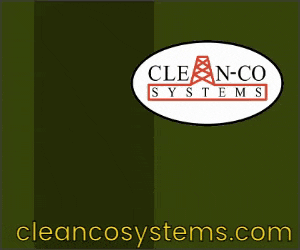 Editor’s note: What follows are summaries of user and vendor presentations made last Tuesday and Wednesday. They illustrate the value of participation in both the 7F Users Group’s 2020 Digital Conference and the organization’s upcoming 30th Anniversary Meeting at the Marriott St. Louis Grand, May 24-28, 2021. To dig deeper, PowerPoints or video recordings of the presentations, are now available on the Power Users website to registered owner/operators. Registration is easy if you don’t already have a “library card.”
Editor’s note: What follows are summaries of user and vendor presentations made last Tuesday and Wednesday. They illustrate the value of participation in both the 7F Users Group’s 2020 Digital Conference and the organization’s upcoming 30th Anniversary Meeting at the Marriott St. Louis Grand, May 24-28, 2021. To dig deeper, PowerPoints or video recordings of the presentations, are now available on the Power Users website to registered owner/operators. Registration is easy if you don’t already have a “library card.”
River Road’s non-chemical approach to cooling-tower algae control
River Road Generating Plant, a 7F-powered 1 × 1 combined cycle, originally used chlorine for algae control in its cooling tower. At the first NPDES permit renewal, the state of Washington’s Dept of Ecology compelled the facility to eliminate the use of chlorine and shift to bromine.
After several years of bromine use, the plant began to experience intense blooms of a resilient and chemically resistant form of filamentous blue-green algae, which was out of control in spring and summer. Algae could grow more than 2 ft/day on sunny days, requiring cleaning of the forebay trash screens every two or three days. A crane was required to dispose of the nominal 2-ton harvest.
With chemical solutions limited, plant management challenged staff to explore the following non-chemical options: electrocoagulation, ozone generation, ultraviolet light, ultrasonic devices, magnetic devices, modulated molecular oscillation pipe wraps, lattice oscillation devices, radio-frequency generators, and cooling-tower shading.
One of the first steps was the trial of an ultrasonic device designed to kill the type of algae affecting the plant in its single-cell form—before it could morph into colonies. The floating transducers emit ultrasonic sound waves that oscillate in frequency, and change periodically, to kill multiple types of biological growth and to prevent mutant strains from developing.
Ultrasonic waves create a so-called “sound barrier” at the water/air interface that prevents some types of algae from floating to the surface for photosynthesis; without surface light, algae die.
Bacteria are killed as well. This means colonies of bacteria are not available to adhere to cooling-tower surfaces. The strand-type algae found at the plant will not attach to surfaces that do not have a layer of biofilm, and the offending cells pass through the system. But while providing a substantial reduction in algae growth, ultrasound did not eliminate the algae infestation during the summer.
Sun shades were considered because algae require sunlight for photosynthesis. This low-tech solution helped to reduce algae growth and the cost of chemical treatment.
RF devices. Ultrasound and sun shades together reduced the amount of algae dramatically, but not completely. Radio-frequency devices, which successfully helped control the effects of biological growth and silica in small cooling towers for HVAC systems, were tested next. The underlying theory is that radio frequency disrupts the lifecycle of the algae in its single-cell form.
Plant and vendor personnel worked together to develop and implement an industrial-scale test plan. The speaker displayed results slides at intervals of about 10 days over a six-week period and the results were compelling. The last slide showed no algae were present. The test was repeated and results were the same. Another benefit: Silica drops to the bottom of the tower basin and is removed during blowdown.
While the benefits of RF devices are impressive—including improved personnel safety, reduced chemical consumption, longer intervals between cleanings of condenser tubes—the speaker pointed out that you never completely eliminate algae because the cooling tower is open to atmosphere. Thus, bromine still is injected, but only every fifth day.
Benefits still to be quantified include the reduction in calcium silicate scale in the condenser and plate heat exchangers, and the reduction in cooling-tower chemicals possible—such as silica dispersant. Stay tuned to CCJ for updates.
GCE replaces exciter during peak demand with minimal financial impact
One of Green Country Energy’s 9A4 generators experienced a ground-fault trip on its Kato brushless exciter because of a winding insulation failure—after nearly 18 years (about 80,000 hours) of service. The nominal 800-MW plant is equipped with three 7F-powered 1 × 1 combined cycles; the steam turbines are married to 9A4 air-cooled generators.
Routine inspections and tests were conducted over the years and the exciter historically had been reliable. The stator had been removed numerous times, the rotor never.
The plant’s highly capable staff was challenged to remove and replace the exciter during a period of peak demand while limiting financial impact. This included the following actions:
-
- Reduce peak-demand forced-outage penalties to the extent possible.
- Locate a replacement exciter.
- Evaluate the risks and rewards of performing repairs onsite.
Several hurdles were encountered:
-
- Kato no longer manufactured replacement brushless exciters for the 9A4. An interesting finding given the 9A4 had been introduced only 20 years earlier.
- No direct-replacement brushless exciter was available from an alternative manufacturer.
- Removal and installation of the exciter rotor requires specialty tooling that the plant didn’t have.
- The repair cycle for rewinding the exciter would require a lengthy forced outage.
The goal was to develop a plan to minimize the forced-outage impact by locating and installing a replacement exciter while the failed exciter was repaired and put in the GCE warehouse. Luckily, a new old-stock spare exciter was located at a partner facility that the plant had shared parts with previously.
Finding the Kato instructions for exciter rotor removal and replacement vague and inaccurate, staff reached out to other plants to discuss their lessons learned and best practices. Some owner/operators reported success, others said there were complications that led to complete removal of the generator field for offsite repairs—attributed to binding of the exciter rotor on the generator shaft.
Thus, the solution was to purchase the spare exciter identified and manufacture in-house the specialty tooling required for removal and replacement. That tooling has since been loaned to at least one other plant.
The bottom line: Plant staff took what easily could have been a three-week outage and completed it in six days, the speaker acknowledging that this was possible because of industry cooperation in obtaining the new exciter and the sharing of experiences by others to develop a good work plan.
ExxonMobil, GE collaborate on development of energy-efficient turbine oil
Mobil SGC™ 918 EE is a new turbine oil designed to provide energy-efficient benefits in GE 7FA and 6FA gas turbine/generators. Developed jointly by ExxonMobil and GE, it is the first product to meet GEK 121603, the OEM’s energy-efficient turbine-oil specification. The new formulation is based on Mobil DTE 932 GT, which the presenter said has been used successfully throughout his company’s frame fleet for the last decade.
According to the user presenting, the new oil provides an overall turbine efficiency improvement when compared to conventional ISO 32 viscosity grade lubricants. Performance was measured in a GE-designed bearing rig, the 7HA test stand, and during 7FA and 6FA field demonstrations.
The speaker reviewed the technical evaluation process used by personnel at the 7F-powered cogen plant charged with the investigation. But before digging into the details, he polled the audience with these two questions:
1. Have you changed the type of lube oil in your gas turbine? Attendee feedback: Yes, 29%; considering it, 20%; no, 51%.
2. For those who did not respond with a “no,” 60% said they performed a full technical evaluation, 18% had the lube-oil suppler to do the evaluation; the remainder simply relied on the experience of others.
The evaluation process described by the speaker began with two 2-hr brainstorming sessions in which key participants participated. After back-and-forth calls over about a week’s time to iron out details, work began with a gathering of P&IDs for the turbine involved in the demonstration. These were used to identify all components and instruments that comprise the following systems: lube oil, hydraulic oil, trip oil, lift oil, and generator seal oil.
Next step was a review of system components by machinery engineers from the plant owner/operator, lubrication experts, and OEM personnel to identify potential concerns with the lower viscosity of SGC 918 EE compared to that of the DTE 932 GT currently used. Note: Because the new formulation is based on the current oil, the evaluation team excluded from review the compatibility of coatings and elastomers with the SHC 918 EE.
The speaker then described the type of matrix used to guide the technical evaluation process. This slide might be of benefit to others considering an oil change—that is, any oil change, not necessarily a switch to SHC 918 EE. One illustration offered concerned lift oil: Would a system adjustment be necessary because of the different viscosity? In this case the answer was “no.”
Another one of the concerns evaluated involved hydrogen seals on the generator: Would there be a need to increase generator seal-oil flow and hydrogen consumption to maintain generator H2 purity? The lower viscosity dictated a change to a bolted seal to maintain hydrogen purity.
The sump for the gas turbine selected to demonstrate the value of SGC 918 EE in an industrial setting has been filled with the new oil; a July restart is planned. Connect to the 7F Forum for progress reports as they become available.
As generators age and unit cycling increases bad things can happen
AGT Services’ Jamie Clark has been on a mission for the last couple of years presenting at the annual meetings of all major users groups to alert owner/operators about the significant increase in generator failures his company and other service firms are seeing. These failures are related in large part to unit cycling and age, with lapses in attention to detail during inspection and maintenance contributing. Recall that most generators at 7F combined-cycle plants were designed for baseload, not cycling, service.
Clark’s presentation last week at the 7F Users Group’s 2020 Digital Conference, “Five minor generator inspections turn into three majors for repairs,” illustrated the dramatic increase in the amount of emergent work some users are experiencing and its costly impact on both maintenance budgets and schedule.
His 7F presentation was similar to one he gave in June 2019 to the Frame 6 Users Group, attesting to the existence of an industry-wide problem, not one affecting a given frame.
Clark began his 7F presentation with a chart illustrating the dramatic increase in the number of starts experienced by a combined-cycle plant in Maine in the last decade compared to the start stats for the facility’s first eight years of service. He then polled attendees, asking how the number of starts in the last 10 years compared to years earlier at their plants. Nearly one-third of the users reported up to a 50% increase in the number of starts; 11% said their starts had doubled; 3% said starts had more than doubled.
Next, he asked the users to share their most common “unplanned” stator repair/upgrade finding during an outage. If you think it is endwinding dusting/greasing or resonance repair, you’re correct. Well over half the respondents said “yes” to that. Other choices were belly-band tightening or new install, stator re-wedging (full or partial), and stator core looseness.
Clark then highlighted the primary areas of the stator affected by cycling, including the following:
-
- Endwinding vibration/loosening, noting the higher risk for strand-to-strand series connections.
- Core looseness impacts, such as keybar rattle/belly bands and loss of core compression.
- Slot support system—including wedge system and side packing/ripple springs.
The speaker stressed that all stator parts are designed to work together as a system. Example: Bellybands restrain keybars and when loose allow keybars to “rattle” producing iron oxide particles. Add in some oil and you have greasing that lubricates the connections, further compromising tightness.
Later Clark would address the many areas of concern cycling poses for fields—including slot component migration, turn insulation migration, copper distortion, braze failures, issues with collector systems, and brushless exciters.
There’s much you can learn from industry generator O&M experience to improve the reliability and availability of your plant. If you were unable to participate in the AGT Services session, access the recording on the Power Users website. How much you learn in only one hour might be surprising.
Come up to speed on today’s turbine tooling
Plant personnel are always challenged to perform outages faster, safer, better than previously; improved tooling might be one way to help you achieve those goals. But it’s difficult to keep up with new developments in a demanding plant environment. A virtual conference benefits in this regard, facilitating learning via field videos of actual work and simulations.
Enerpac had three experts—Mike Beres, Chris Stocker, and Phil Giagnacova—presenting on tooling solutions during its 1-hr session at the 7F 2020 Digital Conference last week. “Optimize maintenance: From turbine decoupling to rotor removal and alignment” was illuminating. It covered turbine-case removal, a safe and efficient coupling-bolt solution, turbine rotor removal, generator rotor removal, journal turning (field machining), etc.
The format was to review the “current state” of each of these applications and then demonstrate the “future state.” To illustrate: The current state of turbine-case removal relies on fixed slings and mechanical turnbuckles. The risks posed by these methods include working from height, ergonomic issues, large heavy components, insufficient adjustability. The future state using the equipment demonstrated focused on hydraulic turnbuckles and adjustable rigging beams. They permit precision adjustment and from a hanging load, allow control away from the lift, and have ergonomic benefit.
The company’s space-efficient ETCT (Enhanced Turbine Coupling Tool) solution was said to save more than six hours in tensioning a 7F coupling than the same job would take with a tool commonly used today. The time to tension joints on four 7FAs at one plant with current-state tooling was estimated at 32 hours. Enerpac tensioned the four units in just over nine hours. This is particularly impressive performance given 60% of users said coupling was on the critical path for their outage.
MD&A’s session focuses on Mark VI/VIe controls, HGP parts, fuel nozzles, generators
MD&A divided its two-hour session last Wednesday into four parts so crammed with information of value to O&M personnel that having recordings of each segment available on the Power Users website benefits both those who missed the presentations and those who didn’t but want to clarify some points. The video format used is convenient, enabling you to identify the information you want quickly.
What follows is a TV Guide-type summary of the material presented:
-
- A Mark VI/VIe presentation by Senior Controls Engineer Joe Clappis focuses on the Toolbos/ToolboxST trend recorder a/k/a trender. It is used for capturing and analyzing data and for troubleshooting—more specifically, for analyzing trip history data (hourly data between trips/stops, trip display data, and information captured by the dynamic data recorder. If you’re unfamiliar with this tool, listen to the half-hour video. Clappis is a highly knowledgeable controls engineer, excellent presenter, experienced teacher, and patient. You might just be introduced to an element of the Mark VI/VIe that can save you considerable analytical time.
- Lifetime extension of 7FA HGP components was covered by Engineering Manager Jose Quinones, PE. Life-limiting factors of HGP parts, lifetime extension steps, implementation of repairs, and upgrades/modifications/improvements are included in the presentation. Quinones moves quickly through this material and you may have to listen to him a second time to confirm specific points. Perhaps the most valuable portion of the presentation is case histories that begin with evaluation of field condition, repair options, possible improvements for life extension, and results.
- Fuel-nozzle end-cover-insert life extension was discussed by GM Joe Palmer of MD&A’s Fuel Nozzle Services Div. He covered system and product lifecycle analysis, technical advancements and life extension, and testing and validation. The graphics used to explain the cracking issue, design enhancements, and repairs are of great value to the unfamiliar user.
- 7FH2 field-winding shorted turns and groundwall failure by James Joyce, a generator specialist at MD&A essentially is a short course the explains what shorted turns are, what causes them, and how to test for shorted turns online and offline. The hot spots and thermal vibration that result from shorted turns are explained. Explanation of rewind and patch-repair options for dealing with shorted turns follows. Groundwall insulation failure is explained in the second part of the presentation. Damage and causes are described along with the recommended repair.









